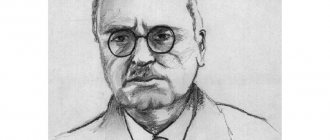Anginophobia - fear of suffocation.
Breathing is a natural and so familiar process that usually a person does not pay attention to it. People begin to consciously control their inhalations and exhalations only when discomfort appears in the organs of the respiratory system.
A painful desire to continuously control the breathing process and a constant fear of unexpectedly suffocating is a sign of a psychological disorder such as anginophobia.
The main cause of the disorder is strong negative emotions experienced in a situation where a person felt a serious lack of air.
The awareness that there is a risk of experiencing an attack of suffocation also negatively affects the psyche of emotional people.
Health status and anginophobia
Anginophobia is closely associated with the following health disorders:
- diseases of the cardiovascular system,
- respiratory diseases,
- inflammatory processes in the larynx.
For example, an attack of angina or a heart attack is a condition that seriously threatens a person’s life. One of the main symptoms of an exacerbation of the disease is a feeling of difficulty breathing. Once having experienced an unpleasant and dangerous state, a person is subconsciously afraid of another crisis .
Phobic fear and constant emotional stress can further weaken an unhealthy cardiovascular system. This is facilitated by excess adrenaline in the blood.
An attack of suffocation is the most well-known symptom of bronchial asthma. Asthma attacks are sudden and severe. In a person suffering from this disease, any slight change in the breathing rhythm can cause panic.
Severe forms of tonsillitis are accompanied by severe sore throat, swollen lymph nodes, inflammation of the tonsils and a feeling of a lump in the throat. These factors create a feeling of tightness in the throat. Abscesses caused by sore throat can cause suffocation. A disease suffered in childhood can greatly traumatize a person’s psyche.
A person suffocates in his sleep: all possible reasons
Cessation of pulmonary ventilation within 10 seconds, caused by a weakening of the tone of the muscles and soft tissues of the throat, as a result of which the airways are blocked and oxygen ceases to flow. A person suffering from this disease feels tired throughout the day. This is perhaps the main manifestation of this pathology. If the patient is overweight, he should sleep only on his side to avoid suffocation.
This is the next reason for lack of air. Patients complain that they seem to forget how to breathe in their sleep. This pathology manifests itself in that the airways are half blocked by soft tissues and it takes 10 seconds or more to restore breathing.
It occurs due to disturbances in the functioning of the brain when there is a failure in the transmission of nerve impulses that cause contraction of the respiratory muscles. The brain seems to forget that the body needs oxygen, and the person briefly holds his breath and stops breathing.
- According to the dream book, if a person suffocates in a dream, this means that serious changes in life await him, and deprivation is possible. Another interpretation is being dependent on a certain person or on certain circumstances.
- From a scientific point of view, such a dream plot can be dictated by physiology: when breathing becomes difficult or stops during apnea, a person experiences suffocation in his dream. However, according to surveys and studies, patients diagnosed with sleep apnea do not see such dreams more often than healthy people.
Choking occurs because the muscles that keep stomach contents from returning to the esophagus weaken. The acid gets into the throat and causes a severe cough, making it difficult to breathe. Thanks to coughing, the throat clears after some time. An important symptom of acid reflux is a sharp feeling of heartburn in the chest area, which can wake a person up.
If bronchial obstruction occurs at night, suffocation also occurs. The person begins to cough, cannot breathe, feels like he is suffocating. Signs of developing an attack of bronchial asthma (appear simultaneously):
- labored breathing;
- coughing;
- wheezing;
- heaviness in the chest;
- arrhythmia.
Associated with the accumulation of large amounts of mucus in the nasopharynx and usually develops against the background of a runny nose. In certain cases, it can occur in completely healthy people. In this case, thick mucus gets into the back of the throat or the back of the nose, blocking the movement of air, and it becomes difficult to breathe.
Other factors influencing the development of fear
- Professional activity that involves a long stay in an environment with insufficient oxygen for a person. Divers, speleologists, miners, etc. may be afraid of suffocation.
- Bad habits. Ethyl alcohol, which is toxic to the human body, has a negative effect on the circulatory system, so alcohol can provoke shortness of breath and attacks of suffocation. In case of substance abuse, to achieve maximum effect, it is practiced to put a plastic bag over the head. Smoking seriously harms the entire respiratory system of the body.
- Tendency to forms of abnormal sexual activity, namely the use of various suffocating means and techniques.
- Feature films that realistically depict strangulation or suffocation.
- Frequent information in the media about severe environmental pollution.
Diagnostics
Regular sensations of suffocation are a reason to immediately consult a physician. He will prescribe a comprehensive examination to determine the true cause of the spasm and oxygen deficiency and refer you for a consultation to:
- ENT;
- cardiologist;
- pulmonologist;
- allergist;
- psychotherapist.
Subspecialists can:
- take a swab from the oropharynx;
- do a pharyngoscopy to study the mucous membranes;
- conduct (examination of internal organs using an endoscope);
- do ;
- give a referral for blood donation (clinical and biochemical analysis, hormones);
- carry out - examination of the mucous membranes of the esophagus, stomach and duodenum.
Manifestation of anginophobia
Anginophobia can manifest itself in different ways. In some cases, a person suffers from frequent obsessive thoughts and attacks of irrational terror that arise for no apparent reason.
Some people develop strong fear under certain circumstances. Fear of sudden cessation of breathing with a completely healthy respiratory system is another form of manifestation of anginophobia.
A person is especially anxious at night, because during sleep he is unable to control inhalation and exhalation.
Physiological symptoms:
- increased sweating,
- heart rhythm disturbance,
- dizziness,
- nausea,
- weakness in the body,
- stool disorder,
- frequent urge to urinate.
External signs of an attack of anginophobia:
- hand trembling,
- trembling lips and chin,
- paleness or redness of the face,
- change in timbre or loss of voice,
- enlarged pupils and restless gaze,
- weakness in the limbs,
- change in facial expressions.
Prevention and treatment
- A person suffering from anginaphobia should avoid unventilated, stuffy rooms. You need to spend as much time as possible in nature. A walk in the fresh air will allow you to breathe deeply and will have a beneficial effect on both your physical health and your emotional state.
- It is worth giving up all bad habits and hobbies that are harmful to your health. This will have a positive effect on the entire body.
- When working in extreme conditions, it is important to follow safety regulations. Confidence that the risk is minimized will help reduce the level of emotional stress.
- If you have cardiovascular or respiratory diseases, a person should study possible options for the development of the disease. It is important to know how to act in emergency situations.
- Detailed information about the structure of the respiratory system will help you understand that breathing is a process that does not require conscious control. It is impossible to suffocate without objective reasons .
When treating a disorder, the psychotherapist’s work is aimed at:
- find out the true cause of fear,
- teach the patient to cope with phobic attacks and quickly recover from them,
- reduce the frequency and severity of attacks,
- improve the general emotional state of the patient.
Symptoms
Signs of a somatic nature, as with any other types of phobic disorders. Panic arises, as a result of which there are difficulties with breathing, this only intensifies the fear.
After all, it seems that here it is, it has happened and now death will really come, either from a heart attack, or from asphyxia.
The following symptoms are also present
- Rapid heartbeat, which is not surprising, because the body decides that danger has come and it needs to try to survive. Why does he launch a program called “salvation”. This is when all resources are activated to accomplish the escape;
- Pre-fainting, and maybe even loss of consciousness;
- Nausea, stomach pain and diarrhea, vomiting (the body seeks to get rid of excess weight that will slow down movement);
- A feeling of heat that may cause you to sweat, despite the cold temperature outside or indoors;
- Tremor of the limbs, numbness, and sometimes chills. By the way, due to tremor and numbness, the gait seems unsteady, a person crashes into pieces of furniture in front of him, into walls and, losing his balance, falls down the steps.
- At the moment of panic, not only control over one’s actions is lost, as well as the ability to adequately assess the situation, but also a so-called “mental stupor” occurs. This is when thinking refuses to work properly, it slows down so much that the pnigophobe is unable to understand what is being said to him.
Fear and feeling of lack of air
Anginophobia is a disorder in which a person himself creates the object of his concern with negative emotions. During an attack of fear, the heartbeat increases, the speed of blood flow increases , which needs more oxygen. In this case, a person experiences a feeling of lack of air, which causes a new wave of experiences.
Often the feeling of lack of oxygen provokes an attack of fear, since the person does not know the true cause of difficulty breathing. If you can understand why it became difficult to breathe and eliminate the problem, then the level of anxiety will partially decrease.
What can cause the feeling of difficulty breathing?
- Any physical activity that increases your heart rate. Shortness of breath is a natural reaction of the body to additional physiological stress.
- Uncomfortable clothing that pinches and constricts various parts of the body.
- Body position.
- Pollution, smoke in the room or environment, thin air.
- Weather conditions: high humidity, dryness, changes in atmospheric pressure, etc.
- Any emotion that increases the beating of the heart.
- Prolonged stay in a confined space.
Diagnosis of VSD
Only an experienced doctor can make a correct diagnosis if a feeling of lack of air occurs during VSD - most people are sure that they have a severe respiratory disorder that requires taking special medications.
However, a thorough collection of complaints and medical history allows the specialist to understand that there were no prerequisites for the formation of asthma or obstructive bronchitis. After all, it becomes difficult for a person to breathe precisely at the peak of negative emotions - anger, stress, emotional turmoil. Relief occurs after taking sedative drops - for example, Corvalol, and not from using an inhaled bronchodilator medication.
In the case of VSD, a person’s shortness of breath does not increase when the pace is accelerated, while panic and fear of dying aggravates the situation. Instrumental and laboratory examinations provide assistance in differential diagnosis:
- radiography of chest structures;
- spirography - checking expiratory speed and bronchial volume;
- electromyography – test for hidden muscle spasms;
- blood tests - reveal a shift in the acid-base state towards alkalization.
Analysis of information in aggregate allows us to reject other diagnoses with signs of lack of air - bronchial asthma, pulmonary sarcoidosis, bronchitis, latent pneumonia.









